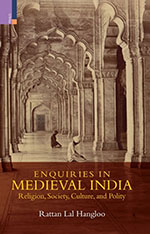R L Hangloo provides a panoramic view of the medieval period with a focus on periodization, medieval state and legitimacy, Sufism and urbanization. By drawing upon case studies from Delhi, Deccan and Kashmir, the author discusses the distinctiveness of medieval politics, diplomacy, religion and culture.
At the outset, he discusses the methodology adopted by colonial and nationalist historians regarding periodization and points out the problems in usage of the term Muslim in place of medieval. He argues that the usage of the ideological lens to understand the medieval period precludes the possibility of objective understanding of the past and the complexities in the making of medieval society (p. xii). He firmly believes that medieval history ‘reverberates’ through contemporary cultural issues as a consequence of misreading of the past. The current focus on socio-economic and cultural history acts a corrective to reading the medieval period as a phase of Islamic tyranny. Next, he analyses the connections between Central Asia and India since the ancient times with an emphasis on the role of Turks in the 13th and 14th centuries. He traces the technological and material advancements of the Central Asian people, their ethnic diversities and details the positive outcome of the establishment of Turkish supremacy on the politics and daily life in North India.
In the following three chapters the author examines the norms of legitimization, creation of royal symbols of power in the Delhi Sultanate and the process of accommodation and assimilation in the religious and cultural sphere in the Mughal empire. He discusses the strategies used by Sultan Balban, Jalal al-Din Khalaji, Ala al-Din Khalaji and Muhammad Tughluq to create political authority and allegiance of subjects. He further highlights the role of the medieval state in shaping the territorial perception of space.

